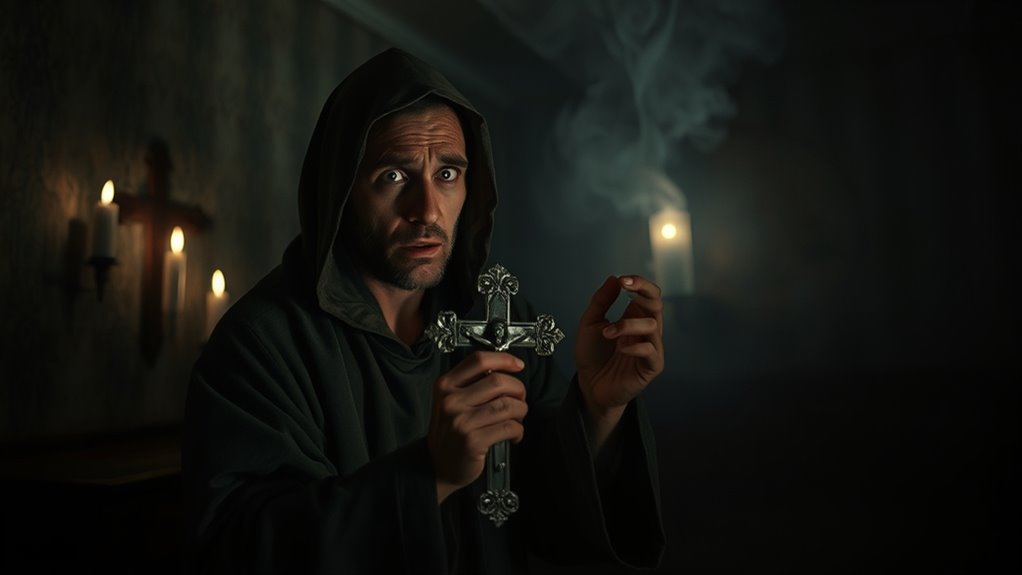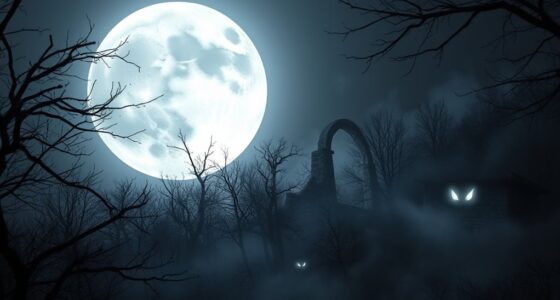Movies often exaggerate exorcisms, making possession scenes overly dramatic with wild contortions, guttural screams, and visual deformities. They also show demons as omnipotent monsters and exorcists as superhuman heroes, which isn’t accurate. Holy water and rituals are portrayed as quick fixes, but in real spiritual practices, they’re part of a longer process. If you want to uncover what movies get truly wrong about demons and exorcisms, keep exploring.
Key Takeaways
- Films exaggerate possession scenes with extreme physical deformities and visual spectacle, misrepresenting actual supernatural manifestations.
- Vocal and physical transformations in movies are amplified for drama, unlike subtle or less intense real phenomena.
- Exorcisms are shown as instant solutions, but in reality, they are complex rituals that require time, faith, and spiritual authority.
- Demons are depicted as one-dimensional evil monsters, ignoring their complex motives and moral ambiguity present in spiritual traditions.
- Movies portray demons as omnipotent and chaotic, whereas in reality, their powers are limited and their actions more manipulative than destructive.
Over-the-Top Possession Scenes
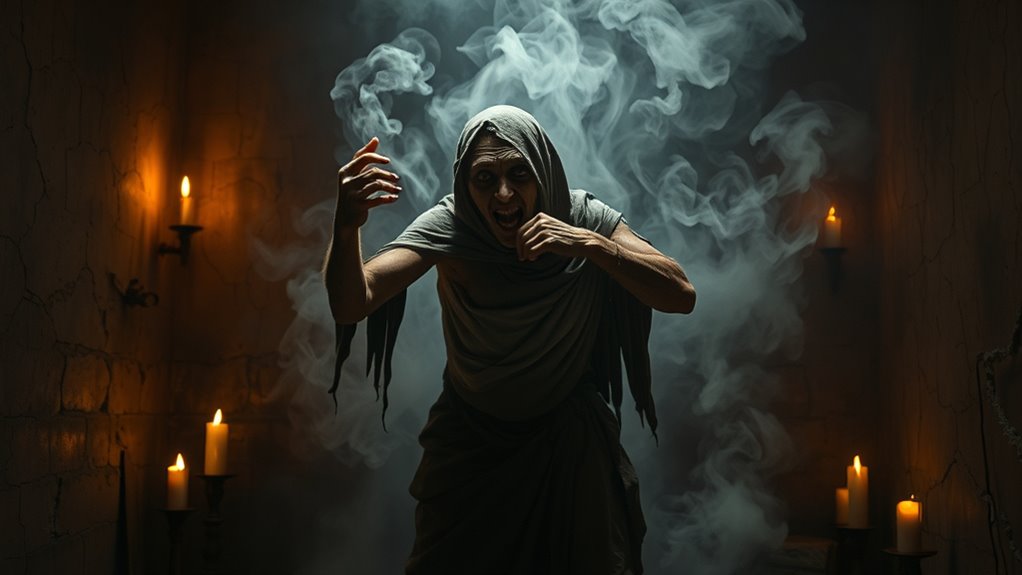
Over-the-top possession scenes are a hallmark of exorcism movies, often designed to shock and captivate viewers. You might see a puppet master-like demon controlling every movement, making the victim’s body seem like a marionette. These scenes heighten the drama with spectral whispers echoing through the room, creating an eerie atmosphere that feels both unsettling and theatrical. The possession becomes a spectacle of wild contortions, guttural screams, and supernatural power, often exaggerated for effect. While these moments grab your attention, they tend to oversimplify the complex reality of possession. Instead of subtle signs or inner struggle, movies emphasize dramatic displays that leave little room for interpretation, making the demon’s influence appear as a terrifying, overt puppet master pulling the strings behind every shocking action. This tendency to dramatize can distort viewers’ understanding of manifestations, which are often more nuanced and less visually spectacular. Additionally, these exaggerated scenes can contribute to misconceptions about what real possession looks like, overshadowing the more subtle and varied experiences reported in actual cases. Sometimes, the portrayal of possession emphasizes spectacle over authenticity, which can lead to misunderstandings about the true nature of spiritual influence. The portrayal of possession as an all-consuming spectacle can lead to misconceptions about the nature of spiritual influence, which may be less dramatic and more integrated into an individual’s inner life. Furthermore, the tendency for over-the-top scenes can reinforce popular stereotypes, which may hinder a more accurate understanding of spiritual and psychological phenomena.
The Dramatic Voice Changes and Physical Transformations
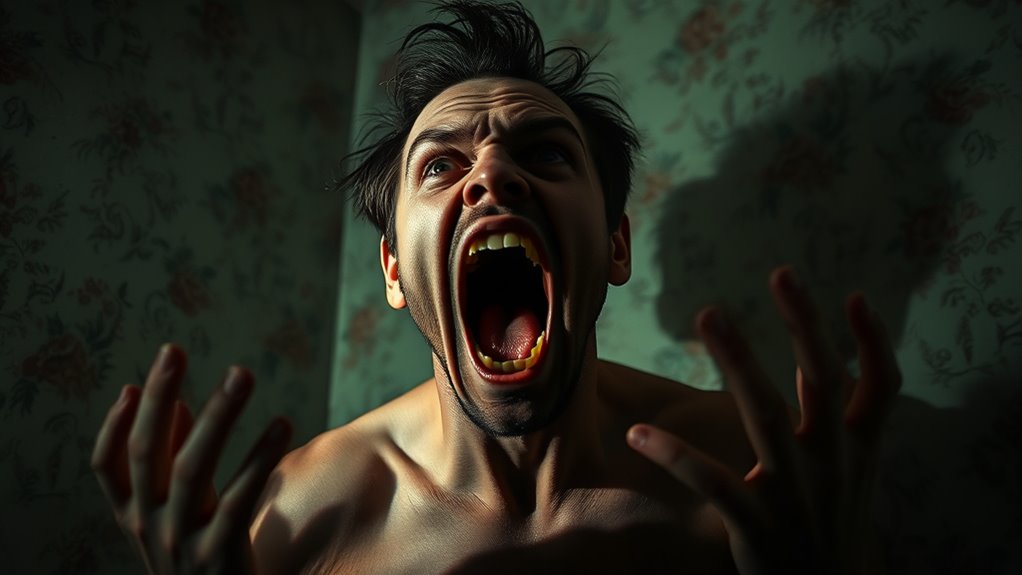
You can’t ignore the power of voice changes and physical shifts during possession scenes in exorcism movies. When actors suddenly alter their vocal pitch or appear physically transformed, it heightens the fear and intensity. These dramatic shifts keep you on edge, making the supernatural forces feel all the more real. Additionally, the use of dog names often reflects the character’s evolving personality or the mood of the scene, adding an extra layer of tension. Recognizing the importance of character development can help explain why these transformations are so impactful in conveying the supernatural’s influence, as well as how special effects are employed to enhance these dramatic moments. Incorporating mindfulness techniques during filming can also help actors portray these intense scenes with greater emotional authenticity, further immersing viewers in the supernatural experience. Understanding emotional authenticity can deepen the audience’s connection to the characters and enhance the scene’s realism.
Vocal Transformations Unveiled
Vocal transformations in exorcism movies often play an essential role in conveying the presence of supernatural forces. They emphasize the demon’s power and evoke fear. These dramatic voice changes often involve deepening or altering pitch, making the demon sound terrifying and otherworldly. Physical distortions accompany these vocal shifts, intensifying the effect. You might notice:
- Unnatural voice modulations that defy normal speech
- Sudden shifts in pitch and tone
- Growls, snarls, or guttural sounds
- Visual cues like contorted facial expressions matching the voice
These techniques create a visceral experience, but they often exaggerate real supernatural phenomena. While they heighten drama, actual vocal transformations are usually less extreme, and physical distortions tend to be more subtle. Vocal modulation is a common technique used to portray demons vividly, though it is often amplified for cinematic impact. Additionally, sound design plays a crucial role in enhancing these vocal effects, making them more convincing on screen. Modern audio technology can simulate complex vocal changes, but many of the most exaggerated portrayals remain artistic choices rather than reflections of real phenomena. For instance, the use of audio filters can significantly alter the perceived voice, adding to the dramatic effect without implying actual supernatural influence. Understanding the psychology of fear can also help explain why these exaggerated features are so effective in horror films.
Physical Changes in Action
Physical transformations in exorcism movies often amplify the intensity of supernatural confrontations by showing dramatic shifts in the demon’s appearance and movements. You’ll notice exaggerated physical deformities that make the demon seem more terrifying, such as twisted limbs or unnatural postures. Facial distortions are common, with contorted features, bulging eyes, or gaping mouths that emphasize its malevolence. These visual cues heighten the horror and suggest an otherworldly origin, but they often exaggerate reality. In real exorcisms, such extreme physical changes are rare or nonexistent. Instead, the focus is on spiritual distress. These exaggerated deformities serve to heighten drama, but they don’t accurately reflect how demons or possession typically manifest physically. Additionally, the portrayal of demons often relies on visual exaggeration to evoke fear rather than accurate representation of supernatural phenomena.
The Use of Holy Water and Rituals as Instant Solutions
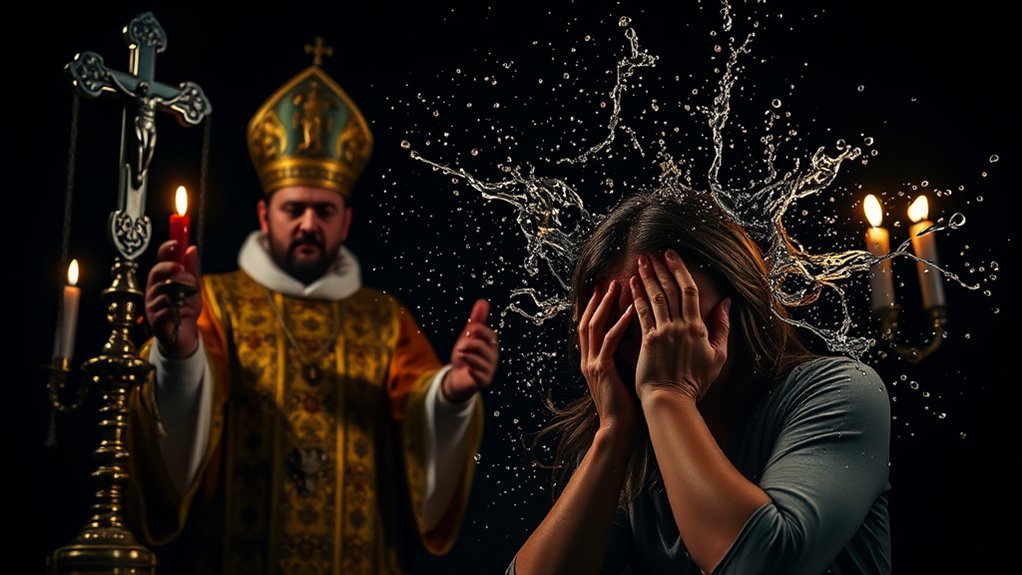
You might see holy water and rituals used as quick fixes in exorcism movies, but they often come with limitations. While they can provide immediate relief, they rarely address the root cause of possession. Relying solely on these quick solutions can give a misleading sense of security and overlook deeper spiritual battles.
Holy Water Limitations
Although holy water and rituals are often depicted as quick fixes in exorcism movies, they have significant limitations in real-life spiritual warfare. Relying solely on these elements oversimplifies complex spiritual battles rooted in medieval lore and misconceptions. Holy water can serve as a blessing, but it’s not an instant cure for demonic possession or attachment. Its effectiveness depends on faith, intent, and spiritual authority.
- Holy water is only one part of a larger spiritual process
- Demons often resist simple solutions, requiring ongoing effort
- Rituals don’t replace genuine spiritual authority or prayer
- Modern misconceptions can lead to false confidence in quick fixes
Understanding these limitations helps avoid unrealistic expectations and emphasizes the depth of true spiritual combat.
Rituals as Quick Fix
Many exorcism movies portray holy water and rituals as quick fixes that instantly banish evil spirits, but in reality, these practices are far from instant solutions. Rituals often involve symbolic gestures that hold spiritual significance, emphasizing the importance of faith and intent rather than immediate results. Ritual symbolism is vital; it helps focus the practitioner’s mind and the community’s collective belief, creating a sense of spiritual authority. However, performing these rituals without understanding their deeper meaning or without proper preparation rarely leads to an immediate exorcism. Instead, they serve as part of a broader spiritual process that may take time and ongoing effort. Don’t be fooled into thinking that a simple gesture or splash of holy water can instantly resolve complex spiritual struggles.
Demons as Malevolent Monsters Instead of Complex Entities
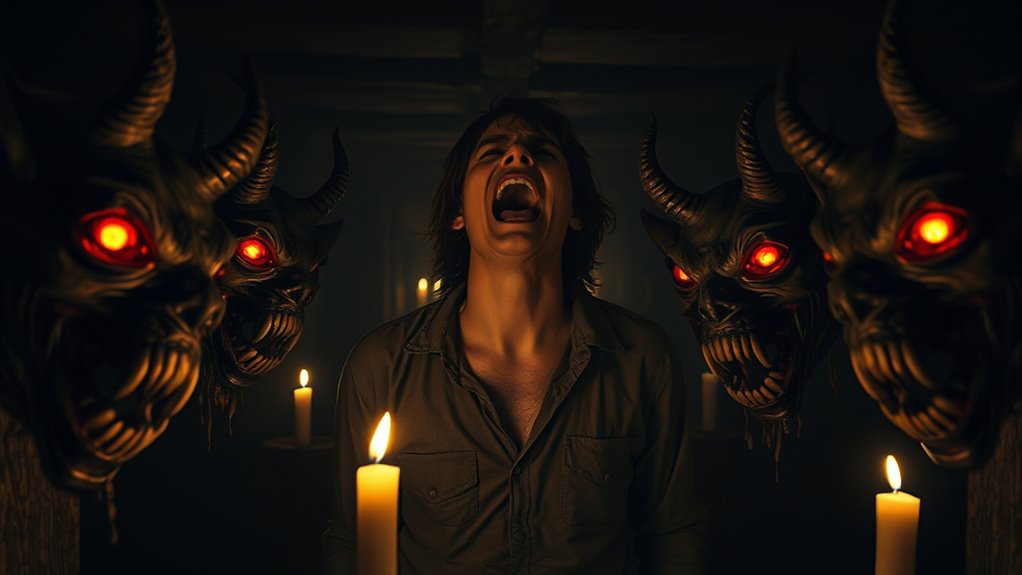
Why do demon portrayals in exorcism movies often reduce them to pure evil monsters? It’s because filmmakers tend to simplify demon psychology, framing them as malevolent beings instead of recognizing their spiritual complexity. This portrayal ignores the nuanced nature of demons, which can embody conflicting motives and emotions. Instead of viewing them as one-dimensional villains, you should see them as complex entities with layered motivations.
- They often reflect human fears and moral ambiguities
- Their malevolence oversimplifies real spiritual struggles
- Recognizing their complexity reveals deeper themes in stories
- Demon psychology suggests they aren’t purely evil but multifaceted
The Portrayal of Exorcists as Superheroes
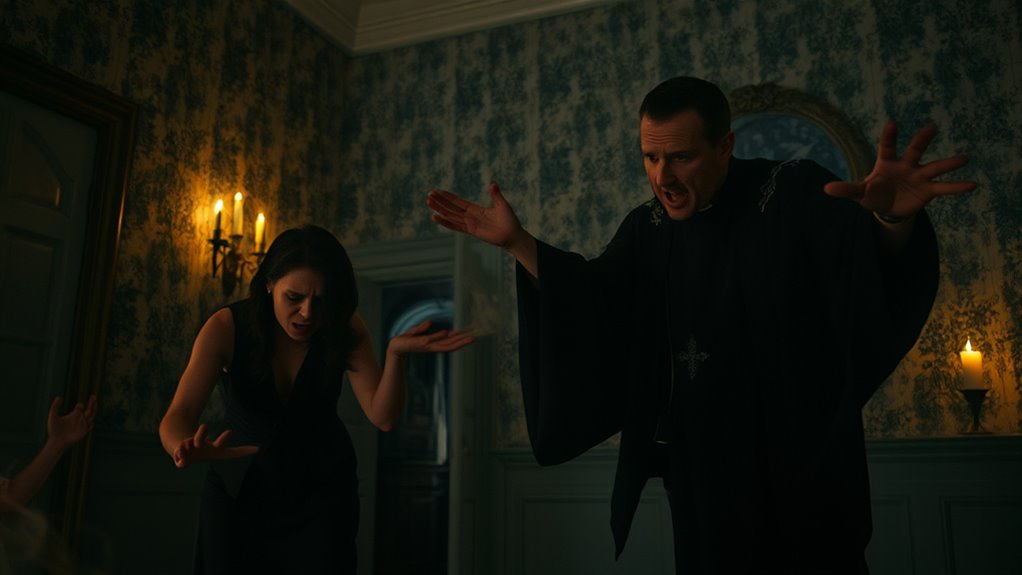
Exorcists in movies are often portrayed as near-superheroes, wielding holy power with certainty and ease. This creates the illusion of superhero exorcists, capable of overcoming demons through exaggerated heroics. They perform miraculous feats, like banishing evil instantly or surviving deadly attacks without injury. These portrayals elevate them beyond real-world clergy, emphasizing their superhuman abilities. The table below highlights common exaggerations:
| Trait | Movie Portrayal |
|---|---|
| Instant success | Immediate exorcisms without struggle |
| Invincibility | Surviving attacks unscathed |
| Supernatural strength | Lifting or smashing objects easily |
| Omniscience | Knowing demon secrets instantly |
| Unwavering resolve | Never faltering under pressure |
While compelling on screen, these exaggerated heroics distort the true complexity of exorcists’ roles.
The Lack of Cultural and Religious Context
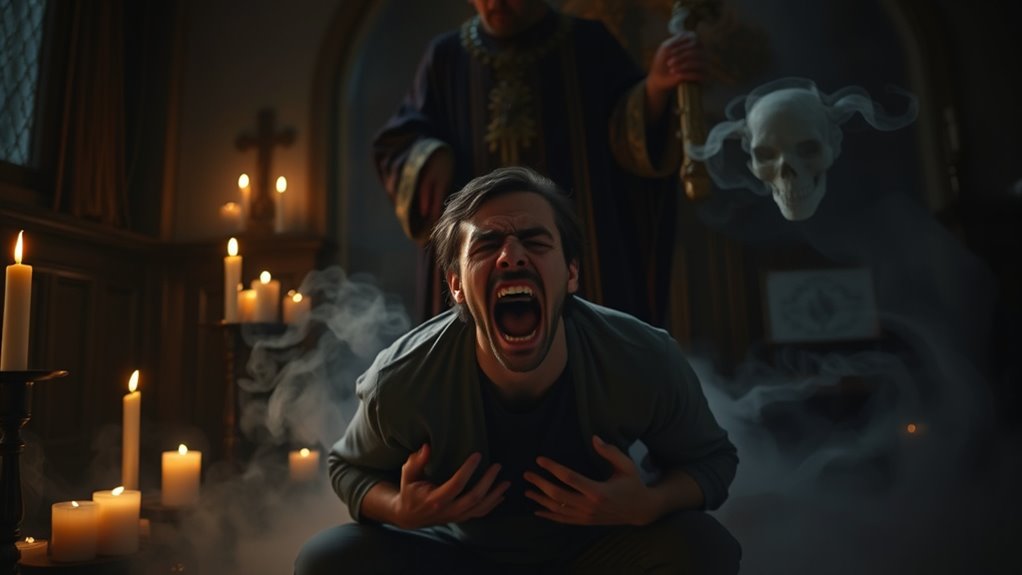
While movies often portray exorcists as isolated heroes wielding supernatural powers, they frequently neglect the rich cultural and religious contexts that shape these practices. This omission leads to cultural misinterpretations and religious oversimplifications, distorting viewers’ understanding. You might see exorcisms as universal rituals, but in reality, they vary greatly across cultures and faiths.
- Different religions have unique beliefs about spirits and possession
- Cultural symbolism influences how exorcisms are performed and understood
- Misrepresenting these contexts fuels misconceptions about spiritual practices
- Ignoring traditions risks reducing complex rituals to Hollywood stereotypes
The Silence and Stillness of Actual Exorcisms
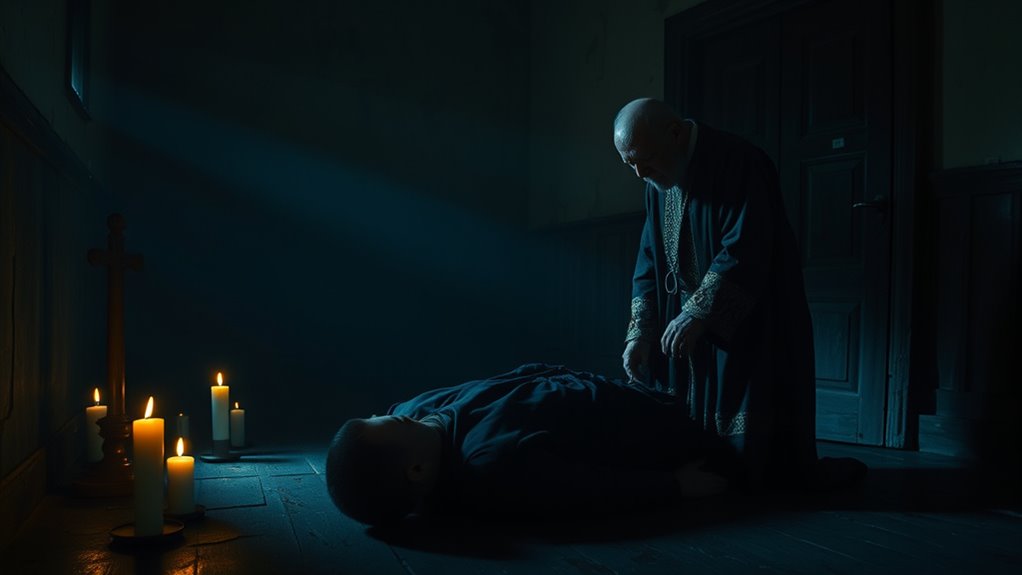
Unlike the dramatic, chaotic portrayals often seen in movies, real exorcisms tend to be marked by an extraordinary sense of silence and stillness. This meditative silence creates a space where spiritual serenity can unfold naturally. Instead of shouting or frantic gestures, you’ll notice a calm quietness that grounds everyone involved. This stillness isn’t passive; it’s intentional, allowing focus on spiritual presence rather than spectacle. The atmosphere feels more like a sacred pause than a confrontation.
| Silence | Stillness |
|---|---|
| Deep focus | Calm presence |
| Inner peace | Sacred moment |
| Quiet strength | Spiritual clarity |
The Misrepresentation of Demonic Intentions and Powers

Movies often exaggerate demonic powers, portraying them as all-knowing, omnipotent entities capable of chaos and destruction on command. In reality, demons often lack clear intent and operate within a complex spiritual nuance that’s misunderstood. You might assume they’re purely malicious, but demonic psychology suggests their motives can be ambiguous or even manipulative. They don’t always seek outright destruction; sometimes, they aim to sow confusion or undermine faith gradually.
- They may appear as tempters, not monsters, exploiting human weaknesses
- Their powers often have limits, contradicting cinematic portrayals of omnipotence
- Their actions can be subtle, not immediately destructive or obvious
- Understanding their true nature requires recognizing the spiritual nuance beyond fear and spectacle
Frequently Asked Questions
How Accurate Are Exorcism Rituals Across Different Cultures?
You might wonder how accurate exorcism rituals are across different cultures. Cultural variations play a significant role, shaping each ritual’s practices and beliefs. While some rituals emphasize spiritual authority and prayer, others incorporate unique cultural symbols. However, the overall ritual authenticity varies widely, and many practices are based on tradition rather than scientific validation. Understanding these differences helps you appreciate the cultural richness behind each exorcism.
Do Demons Truly Possess People or Is It Psychological?
Is a demon truly taking control, or is it a shadow cast by your mind? You’re caught between psychological explanations, which see possession as mental illness, and spiritual interpretations, viewing it as an actual spiritual invasion. While movies dramatize demonic possession, real cases often reflect psychological struggles. Ultimately, understanding depends on your beliefs—whether you see demonic influence as real or as a manifestation of inner turmoil.
What Are Common Misconceptions About Demonic Possession?
Many people believe possessed individuals exhibit extreme behaviors, but most cases are psychological rather than demonic. You might think possession involves evil entities taking over, but demon origins are complex and often misunderstood. Movies tend to dramatize these events, suggesting all unusual behaviors stem from demons, but in reality, mental health issues are more common. Recognizing the difference helps prevent misconceptions about demonic possession and mental health.
Are There Real-World Cases Similar to Movie Portrayals?
Skeptic investigations show real-world cases rarely resemble movie mayhem. Cultural variations influence perceptions, making some experiences seem supernatural. You might encounter stories of strange sensations or unusual activity, but experts often attribute these to psychological, physical, or environmental factors. While some believe in genuine demonic encounters, most documented cases lack concrete evidence, highlighting the importance of skepticism and scientific scrutiny over sensational stories.
How Do Religious and Cultural Backgrounds Influence Exorcism Practices?
You should recognize that your cultural rituals and religious beliefs heavily influence exorcism practices. Different traditions have unique methods, prayers, and symbols rooted in their worldview. For example, some cultures emphasize spiritual cleansing through specific rituals, while others rely on prayer and faith. Your background shapes how you understand possession and the steps taken to address it, making exorcism a deeply personal and culturally embedded practice.
Conclusion
As you watch these movies, you might notice how the exaggerated scenes often mirror real-life fears, almost as if they’re echoes of ancient stories. Yet, behind the dramatics, the truth is more subtle and complex. Sometimes, it’s strange how a simple ritual or quiet moment can reveal more than all the spectacle. Maybe, in the end, the real power lies in understanding the deeper, often unseen, layers of faith and human experience.
